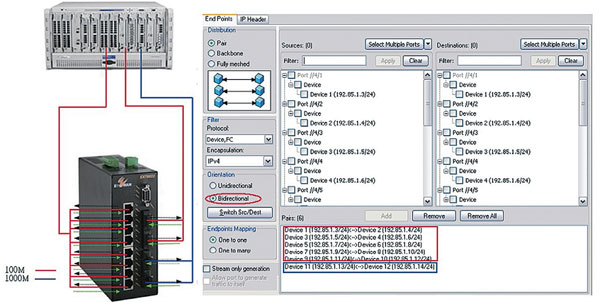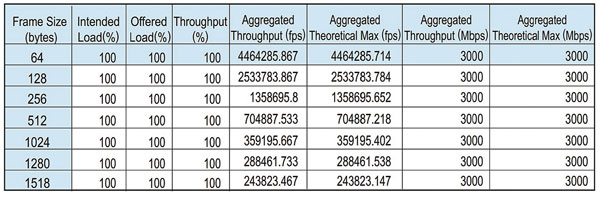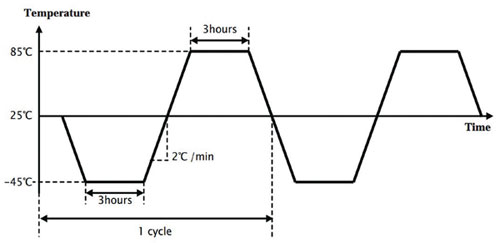 The rapid development within modern IP technology hasn't evaded the security industry. IP surveillance systems are becoming more and more popular and 2014 will be a historic year since this is the year when the CCTV and video surveillance market will come to a "tipping point", with revenue for network video overtaking analogue for the first time ever, according to a new report entitled "The World Market for CCTV and Video Surveillance Equipment" from IMS Research.
The rapid development within modern IP technology hasn't evaded the security industry. IP surveillance systems are becoming more and more popular and 2014 will be a historic year since this is the year when the CCTV and video surveillance market will come to a "tipping point", with revenue for network video overtaking analogue for the first time ever, according to a new report entitled "The World Market for CCTV and Video Surveillance Equipment" from IMS Research.
In other words, an increasing number of new surveillance projects are now completely IP-based and they need qualitative network equipment to work properly. There are a lot of different network peripherals on the market, but a main question is: how do you choose and use them efficiently to ensure your system reaches the maximum performance in every operating environment?
All available image monitoring and traffic processing capabilities of a device can and should of course always be tested in the hunt for optimised performance. However, these assessments of different types of IT devices have to be done correctly in order for the output data to provide critical information on the device capabilities. Here we examine the commonly heard of "backbone full wired speed" and "PoE capability" to see how these functions should be defined and tested.
Key product – switches*
One large product group that is important to know about when setting up a camera system for IP surveillance is switches. A network switch, or switching hub, is a computer networking device that connects network segments. The network switch plays an integral part in most modern Ethernet local area networks (LANs), and a network can have more than one switch. The switch only sends data to the receiver that is supposed to have access to the given information. In this way, a network doesn't overload when data is sent. It also means higher security as it is hard to gain access to information not meant for another computer.
Switch performance
Non-blocking and wired-speed both refer to the performance of an Ethernet switch. With a 24 port 10/100/1000 switch, if each port is 2G in full duplex mode, then 24 ports means the device is a 48G switch. When this volume of data is passed through the switch, the switch performance can be categorised as non-blocking or wired speed. If the switch is connected to another switch, or to a server that uses network storage or transfers, then non-blocking is essential. Yet, how this is accomplished is up to the vendor's switch design. The user can only rely on the data provided by the vendor. Otherwise, the user must test the switch's capability using tools such as Spirent Testcenter Smartbits. It is not possible to derive the switch's capability from just the port configuration. Let us now use the Spirent Testcenter to test a switch and see how the report shows that it is "full wired-speed".

Figure 1. All cables are connected and data transfers set up between pairs of RJ45 ports.
Testing a switch
As shown in figure 1, all cables are connected and data transfers set up between pairs of RJ45 ports (check the option for "Bidirectional"). Full duplex transfers of different packs were also carried out at the same time. If the test showed that the device supports "full wired-speed", then the numbers for "Aggregated Throughput" and "Aggregated Theoretical Max" and in the following graphs should match. As the ports were paired for testing, actual throughput should be 3000 Mbps x 2 = 6000 Mbps (6 Gbps).
The specifications for the switch used here was 10-port 10/100 BASE (8 x PoE) with a 2-port Gigabit Ethernet Switch (10 x 100 Mbps + 2 x 1000 Mbps) = 3000 Mbps. Under full duplex mode, the operating bandwidth should be 3000 Mbps x 2 = 6000 Mbps. Our calculations were consistent with the actual test results, so this switch supports full wired-speed. While it is not that easy to obtain the necessary testing equipment to carry out the experiment when we put these devices into service, we can still ask the vendor to provide test reports shown as figure 2 that back up their claims.
 Figure 2. Example of a test report.
Figure 2. Example of a test report.
Needs adjustments
One can't expect to operate equipment at their full capacity over an extended period of time. Not only is this poor infrastructure planning, it also places significant stress on the equipment and indirectly impacts network stability. In actual applications, once the equipment performance has been fully understood, appropriate performance adjustments must continuously be made. These adjustments should include network device management and data traffic planning. The equipment must also have spare capacity to avoid structural malfunction when there is a sudden change in the network environment.
PoE capabilities**
PoE (Power over Ethernet) is a convenient and cost-efficient power solution for IP surveillance systems. Power over Ethernet technology describes a system to pass electrical power over Ethernet cabling, along with data. This means that a network device can be powered and operated using the same cable as for network connection, eliminating the need for power outlets close to an IP camera, for example.
Two types
Most PoE switches come in two types off-the-shelf: "guarantee per port" operation and "total power budget" operation – both useful in their own way.
Guarantee per port – this type of PoE switch provides a lot more flexibility to users when planning and expanding their IP surveillance system. PoE switches that act as power source equipment (PSE) should successfully feed sufficient power to connected powered devices (PD) after retrieving the power consumption information of each IP camera and comparing the data to the total number of connected IP cameras. When each port is guaranteed a full power design in compliance with either IEEE802.3af or IEEE802.3at, the switch is effectively plug-and-play. No sophisticated engineering effort is needed, however these switches might be bigger, more expensive and best used in a controlled climate.
Total power budget – this often cheaper PoE switch operates as a "total power budget", but users need to consider a number of points when selecting this type of system. For instance, features like pan-tilt-zoom, cooling fans, heaters or infrared illuminators may require extra power. If the total power consumption is over the total power budget of the PoE switch, it may cause the entire system to malfunction. Users should accurately measure the total power of all devices to effectively avoid errors from occurring in the field.
PoE testing
When an IP surveillance system is planned, users may perform a simple test, under room temperature, by connecting the IP cameras to all PoE ports on the switch. Users should let the system run for a few days to see if it is operating at a stable rate. If it is, users are highly recommended to test the system again under a full workload and various operating temperatures. Occasionally, instability will occur under long periods with a high workload or in rapidly fluctuating temperatures. A good PoE switch should be able to withstand functional and environmental challenges.
PSE Conformance Testing can be performed in quality assurance labs. A test suite can analyse hundreds of test parameters depending upon the capabilities of the PSE. These parameters are measured in several distinct tests that cover most of the PSE PICS (conformance check list items) in the IEEE 802.3at/af specifications.
 Figure 3. Environmental testing standard of switch with PoE/PD load to stimulate full workload.
Figure 3. Environmental testing standard of switch with PoE/PD load to stimulate full workload.
Temperature
Figure 3 shows the environmental testing standard of a switch with PoE/PD load to simulate a full workload. Passing conditions should ensure the switch can operate continuously under low and high temperatures without any data transmission errors.
Reviewing product specifications is only a basic step of the PoE switch decision making process. Making the right decision requires a comprehensive testing report to ensure that the network product is designed with high quality engineering. Only then will you be able to count on them for the success of your surveillance system.
After PoE comes PoL
Generally speaking, Power over Ethernet technology is a useful tool for solving power source issues, however there are also limitations relating to the applied media and distance. An alternative to compensate the PoE technology limitations is PoL (Power over Link) technology. PoL supports power over one twisted copper pair and coaxial cables, and the distance can be over 1 kilometre. This new technology makes projects more flexible and efficient. It is also easy to use, and this technology should also be included when evaluating TCO (total cost of ownership) benefits.
* You can read more general advice on getting the correct switch for your surveillance needs in the Detektor Security Adacemy article "Infrastructure for efficient IP surveillance".
** You can read more on PoE in the Detektor Security Academy article "Effective IP surveillance with Power over Ethernet".
About the sponsor
EtherWAN Systems, founded in 1996 with the US headquarters in California and the Pacific Rim headquarters in Taiwan, has become a leader in Ethernet connectivity for applications in various markets including IP surveillance, intelligent transportation systems (ITS), electric utility, oil and mining, factory automation, etc. EtherWAN specialises in designing and manufacturing fibre optic Ethernet products and Ethernet equipment made especially for harsh environments. Technical engineers are available for network topology consultancy.
For more information about EtherWAN's solutions, visit: www.etherwan.com
Contact info: info@etherwan.com.tw















